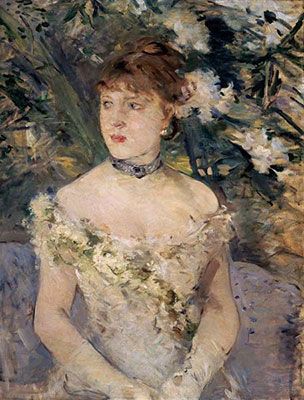

Morisot's Impressions, like Renoir's, forced the viewer to think less about the represented subjects than about the transformation of them on canvas. The Artist's Daughter Julie, with Her Nanny (The Sewing Lesson) and Interior of a Cottage are gloriously painted drawings in which each line is a color sensation. In the latter, Morisot painted. Berthe Morisot was a French painter and printmaker involved in the Impressionist movement. View Berthe Morisot’s 738 artworks on artnet. Find an in-depth biography, exhibitions, original artworks for sale, the latest news, and sold auction prices. See available works on paper, paintings, and prints and multiples for sale and learn about the.
- The Cradle (1872) Artwork description & Analysis: The Cradle is arguably Berthe Morisot's most famous painting. It depicts Morisot's sister Edma gazing down at her daughter Blanche, who is asleep in a cradle behind a gauzy veil. This relatively early work is the first example of Morisot's treatment of.
- During this time Morisot began to exhibit her work, with her first show at the Salon in Paris in 1864. Cordot was pleased with his protege's work and allowed her to sign her paintings as a 'student of Cordot.' Morisot went on to exhibit her paintings at Salon shows in 1865, 1866, 1868, 1870, 1872 and 1873.
- The lengthy, unkempt brushwork is typical of Morisot's work from the late 1870s, which, as Nathalia Brodskaia has noticed, created a 'vibration of color and light' previously unseen in her paintings. Morisot's work invites comparison with her fellow Impressionist Mary Cassatt's Woman with a Pearl Necklace in a Loge, painted in exactly the same year, 1879. In Cassatt's painting, a similarly formally.
The 'point' of Impressionist art was to capture the fleeting moment, the transient effect of a certain place, person, or time. Impressionist artists worked on-site with speed and directness, hoping to distinguish their works with a new freshness, immediacy, and truthfulness. Yet the paintings they exhibited were in fact almost always completed in the studio later. This beautifully illustrated book investigates for the first time the works that might truly be called 'Impressions'—paintings that appear to be rapid transcriptions of shifting subjects but were nonetheless considered finished by their makers. Renowned Impressionist scholar Richard R. Brettell identifies and discusses Impressions by some of the best-known artists of the period, including Manet, Monet, Renoir, Sisley, Morisot, Degas, Pissarro, and Caillebotte.
The book surveys the various practices of individual artists in the making, signing, exhibiting, and selling of Impressions. Brettell discusses the pictorial theories behind the paintings, the sales strategies for them, and the various forms they took, including works completed in one sitting, 'apparent' Impressions, and repeated Impressions. In a concluding chapter, the author considers a small group of works by Vincent van Gogh, who painted with an almost fanatical rapidity and was the only major Post-Impressionist painter to push the aesthetic of the Impression even further.

This book is the catalogue for an exhibition at the National Gallery in London from November 1, 2000, to January 28, 2001, the Van Gogh Museum in Amsterdam from March 2 to May 20, 2001, and the Clark Art Institute from June 17 to September 9, 2001.
Berthe Morisat Taining Period Artwork

Berthe Morisot Works
240 pages, 9 3/8 x 11 inches
183 color and six black-and-white illustrations
2000
Published in association with Yale University Press
ISBN 0-300-08446-3 (hardcover)
ISBN 0-300-08447-1 (softcover)